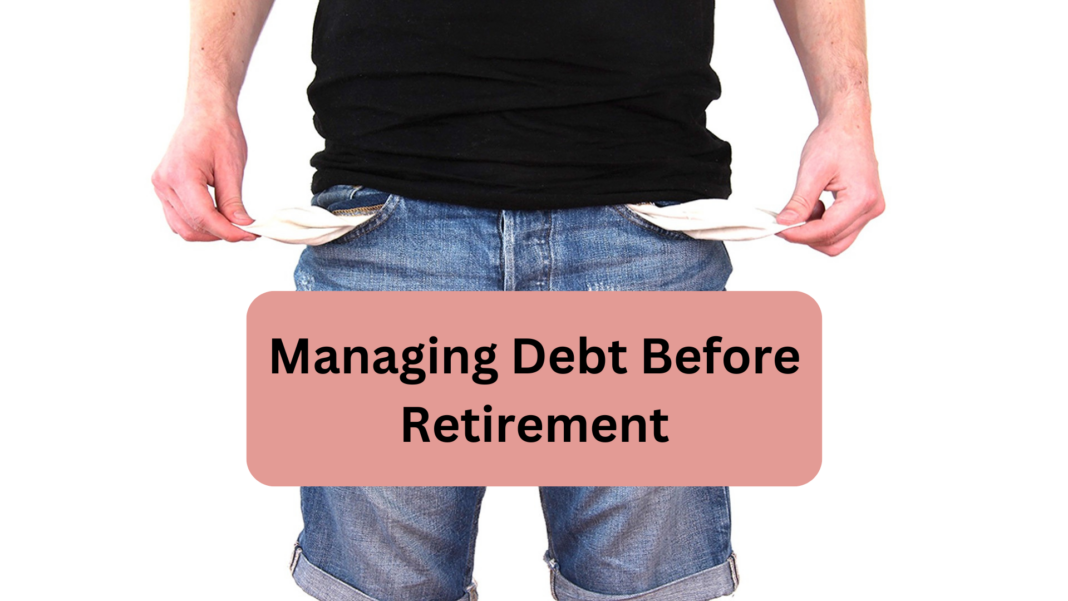While many enter this period in their lives with great expectations, retirement is a time to finally be able to relax, go on trips, and catch up with dreams that have had to take the backseat. To those saddled with debt, however, the golden years may not be quite so golden. The shadow cast by debt in retirement casts over plans that inhibit financial freedom and add stress to a period meant to be enjoyed easily. This, therefore, brings into important focus pre-retirement debt management and reduction on the way to a secure, comfortable future.

This comprehensive guide aims to investigate some of the best strategies that will help one tame debt in the years leading up to retirement. We shall discuss why it is important to manage debt, consider various types of debt, and outline some practical steps you can take to reduce your financial obligations. Whether a few years or a decade away from retiring, this article will help shed light on how best to achieve a debt-free, or at least debt-reduced, retirement.
Understanding the Effects of Debt on Retirement
Before delving into effective strategies in debt management, it is necessary to understand the effects carrying debt into retirement years can have on financial well-being.
Reduced Income in Retirement
Fixed Income Challenges: Many retirees depend on fixed incomes derived from Social Security, pensions, or retirement account distributions. Payments toward debt significantly diminish what is needed and available for day-to-day living.
Increased Financial Stress: Juggling debt payments and living expenses may lead to financial stress and anxiety.
Decreased Flexibility
Constrained Choices in Lifestyle: The requirement to service debt will place you in a tight spot whereby you have to make difficult choices between bill payments and the enjoyment of retirement activities.
Broader Challenges in Managing Emergencies: When part of your income is committed to debt service, handling unexpected expenses becomes more difficult.
Possibility of Compounding Debt
- Risk of Using Credit: Because of this deficit, some retirees may need to resort to credit cards or loans, which could initiate them into the possibly vicious circle of increasing debt.
- Impact on Credit Score: Failing to pay your debt will reduce your credit score, making future loans or attractive interest rates more difficult to access when you need them.
Types of Debt to Address Before Retirement
Not all debt is considered equal. Certain types of debt are more important to pay off before retirement, while others are not as urgent:
High-Interest Credit Card Debt
- Priority: Highest
- Why: Credit card debt often falls into the highest interest rates; thus, it usually costs the most to keep over longer periods.
- Impact: Compound interest can cause debt to balloon rapidly, thus setting back retirement savings.
Personal Loans
- Priority: High
- Why: Usually not secured, can have a high interest rate.
- Impact: Fixed payments stress lowered retirement income.
Auto Loans
- Priority: Medium to High
- Why: Depreciating assets with ongoing costs (insurance, maintenance).
- **Impact: Can inhibit financial flexibility in retirement.
Mortgage Debt
- Priority: Varies
- Why: Lower interest rates and potential tax benefits place this lower priority compared to other debts.
- Impact: Large monthly payments can strain retirement budgets, but home equity can be a valuable asset.
Student Loan Debt
- Priority: Varies
- Why: Federal loans offer income-based repayment options and potential forgiveness.
- Impact: This can be substantial if co-signed for children or grandchildren.
Strategies for Managing Debt Before Retirement
Now that we have gone over the various types of debt on which to focus let’s go into some strategies for addressing these financial obligations:
- Make a Detailed Listing of Debts
First, get an idea of what your debt looks like and feels like:
- Name All Your Debts: Make a list of all the debts owed: state the creditor names, current balances, interest rates, and month-to-month payments.
- Calculate Your Overall Debt: Add up all the balances to see how much you owe.
- Check Which Interest Rates Are Applied: Identify which debts carry the highest interest rates.
- Create a Strategy for Paying Off Your Debt
Choose which strategy works best for your situation:
Debt Avalanche Method
- How it Works: Focus on paying off the highest interest rate debt first while making minimum payments on others.
- Benefit: Saves the most money on interest over time.
- Best For Those who have the discipline to stick with it and want to minimize interest payments.
Debt Snowball Method
- How it Works: Pay the tiniest debt first and then roll that money into the next smallest debt.
- Benefit: Gives quick wins and motivation as you may see debts disappear.
- Best For Individuals who need psychological boosts to stay motivated.
3. Increase Your Debt Payments
Find ways to free up more money toward your debt settlements:
- Cut Unnecessary Expenses: Review your budget and save toward debt payments.
Put Windfalls to Work: Use tax refunds, bonuses, or gifts against your debt.
Start a Side Hustle: Utilize income from part-time jobs or freelancing work to accelerate your debt payments.
4. Negotiate with Creditors
One should not be afraid to ask for better conditions:
Request Lower Interest Rates: This is especially possible in credit card debt if one has paid back diligently.
Look into Hardship Programs: Many creditors have programs that allow for temporary reductions in payments or even interest rate freezes.
- Consider Debt Consolidation: If this person has multiple debts, consider consolidating them into a single loan with a reduced rate of interest. This would make payments simpler and reduce the total interest paid.
5. Pay High-Interest Debt First
Pay off high-cost debts first:
- Attack Credit Cards: Pay more than the minimum against credit cards with the highest interest rates.
- Try Balance Transfers: If possible, transfer the amount owed to high-interest credit cards to credit cards offering 0% introductory rates; be aware of the fees charged for this transfer and time limits.
- Reassess Your Mortgage Situation
Consider your mortgage debt management options:
- Refinance: You may refinance should interest rates fall and lower your monthly payments.
- Downsize: Sell your home and move into a more affordable property to unlock equity.
- Reverse Mortgages are an Option: If you are aged 62 and above, you can consider a reverse mortgage, although it is wise to tread with caution as there are pros and cons involved.
- Attack Your Student Loan Debt
If you have student loans, consider repayment options:
- Income-Driven Repayment Plans: Federal loans will allow some payments based on your income level.
- Loan Forgiveness Programs: Some careers offer loan forgiveness if a certain number of payments have been made.
- Don’t Co-Sign: If at all possible, don’t take on new debt for your sons, daughters, or grandchildren.
8. Build an Emergency Fund
While concentrating on getting out of debt, don’t stop your emergency fund buildup:
- Start Small. Even a small emergency fund can prevent you from incurring further debt when sudden expenses occur.
– Aim for 3-6 Months: Work your way up to save 3-6 months of living expenses in a readily accessible savings account.
9. Get Professional Advice
Consider taking professional advice from the following:
Financial Advisor: A person who could give an overall plan that may balance the payback of debt with retirement savings.
- Credit Counselor: Provides advice on the way of paying debt and may even intervene with the creditors.
- Tax Professional: Can suggest to a consumer the tax consequences of a particular strategy pertinent to debt settlement.
Balancing Debt Repayment with Retirement Savings
Though debt is an essential item to handle, retirement savings are also not to be left behind:
Don’t Stop Contributions towards Retirement
- Employer Matches: At a minimum, contribute enough to your 401(k) to get any employer matching dollars-it’s free money.
- Catch-Up Contributions: If you’re 50 or over, take advantage of catch-up contributions to IRAs and 401(k)s.
Consider the Interest Trade-Off
- Compare Rates: When your debt interest rate is less than your expected return on investment, it might be a good idea for you to invest while you pay minimums.
- Factor in Tax Implications: Most retirement account contributions have tax advantages of one kind or another.
Build a Balanced Approach
- 50/50 Split: You may want to consider putting additional money, 50% towards debt and 50% towards retirement.
- Adjust as Necessary: Periodically take a look at what you are doing and make changes based on your progress and changes to your situation.
Lifestyle Changes that Can Support Debt Repayment
Effectively getting control of debt sometimes requires some changes to your lifestyle:
Lower Housing Costs
- Downsize Early: Moving into a smaller house or lower-cost region can unlock dollars for debt reduction.
- Rent Out Space: If at all possible, consider renting out a room or your garage as an additional source of income.
Reduce Transportation Costs
- Sell an Extra Vehicle: If you have multiple vehicles, sell one to relieve yourself of payment and insurance costs.
- Public Transportation: Public transportation in urban areas can be an economical alternative to car ownership.
Reduce Entertainment Expenses
- **Free Activities: free community events, parks, and libraries.
- Entertain at Home: Host potluck dinners instead of eating out.
Reevaluate Subscriptions and Services
- Cut Cable: Switch to cheaper streaming services or use an antenna for local channels.
- Review All Subscriptions: Cancel unused gym memberships, magazines, or online services.
Shop Smarter
- Use Coupons and Cashback Apps: Take advantage of discounts and rebates.
- Buy Generic: Choose store brands over name brands for significant savings.
Avoiding New Debt as You Approach Retirement
While you’re working to pay off current debt, it’s important to avoid taking on new debt:
Live Within Your Means
- Create a Realistic Budget: Chart your income and expenses and ensure you don’t overspend.
- Use Cash or Debit: Avoid making ordinary purchases with credit cards.
Plan for Large Expenses
- Save in Advance: Start saving for identified future needs like repairing the home or appliances.
- Find Alternatives: Repair instead of replace or buy used instead of new.
Resist Family Financial Pressures
- Set Boundaries: Clearly communicate your financial constraints with family members.
- Offer Non-Financial Support: Help in ways that may not relate to money, such as babysitting or sharing skills.
Postpone Major Purchases
- Wait on Big-Ticket Items: Put off big purchases until you are further along in paying your debt.
- Avoid Pre-Retirement Splurges: Avoid spending money on extravagances like vacations and high-priced items before retirement.
Tracking Your Success
Some of the key ways to stay motivated and up-to-date include:
Monitoring Your Debt
- Use Debt Reduction Apps: Websites and tools like Mint or YNAB help you visually see your progress.
- Celebrate the Small Stuff: Celebrate the day you pay off a credit card or achieve a certain percentage of your goal.
Review Your Plan from Time to Time
- Quarterly Reviews: Dedicate time every three months to reviewing your debt repayment progress and making any necessary adjustments.
- Annual Financial Check-Up: Every year, thoroughly review how much one owes, how much one has managed to save, and how healthy one’s finances are.
Keep Learning
- Read Financial Books and Blogs: Go through personal finance and debt management literature.
- Attend Workshops: Look out for free seminars on financial education in your locality.
Conclusion
Debt management before retirement is an absolute necessity to ensure security and enjoyment in post-retirement life. Making a debt plan for retirement will be easier if one learns the ways debt can affect retirement, identifies high-priority debts, and strategically deploys money to repay them.
First, the road to debt-free living is often a marathon and not a sprint. Patience, discipline, and tough choices are part of this. However, the peace of mind and financial freedom you enjoy in retirement, debt-free, make the effort well worth it.
As you work your way on how to manage debt, remember these key points to keep in mind:
- Prioritize high-interest debts, especially credit card balances.
- Debt avalanche or snowball are a couple of techniques to help one stay motivated.
- Retirement savings are often forgotten amidst debt repayment-hence, work out a balance.
- Make the required lifestyle adjustments to accommodate your goals of debt repayment.
- Avoid further debt as you approach retirement.
- Periodically review the progress and rework on the plans as necessary.
Take control of your debt now and invest in a more secure, more enjoyable retirement future. Start now, stick with the plan, and look forward to that first day of retirement when you can confidently enter retirement debt-free.
Remember, it is never too late to begin managing debt. Whether retirement is a long way off or just beyond the horizon, the earlier you start taking action, the better you will be once those retirement years arrive.






